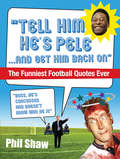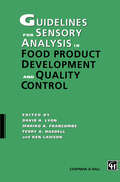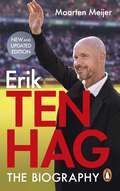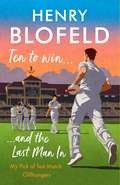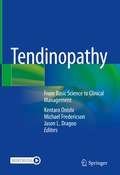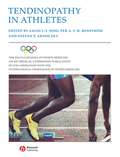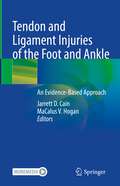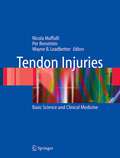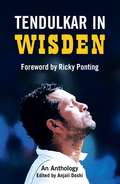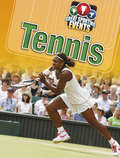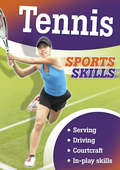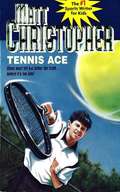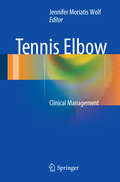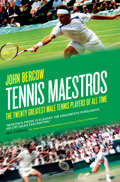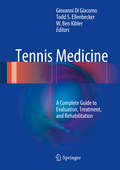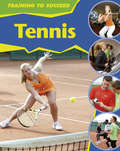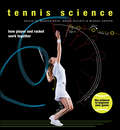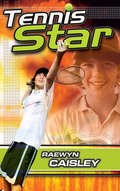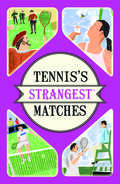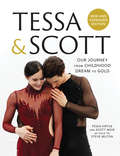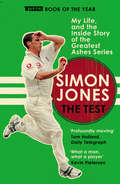- Table View
- List View
Tell Him He's Pele: The Greatest Collection of Humorous Football Quotations Ever!
by Phil ShawMy parents have always been there for me, ever since I was about seven - David BeckhamFor Tony to admit he is an alcoholic took an awful lot of bottle - Ian Wright on Tony AdamsI've been playing in a golf day for a boy seriously injured in a car accident. I had to drive like a lunatic to get here - Ray Houghton, TalkSport football pundit, on why he was late on-airReporter: What would you be if you weren't a footballer?Peter Crouch: A virgin.I've never been so certain about anything in my life. I want to be a coach. Or a manager. I'm not sure which - Phil NevilleFootballers may not be known for their profound insights, but it seems no one in the game is above a mixed metaphor or confused cliché. From Harry Redknapp to Martin O'Neill, Patrice Evra to Jason McAteer, see the funny side of the beautiful game with this hilarious collection of verbal own goals. Packed full of hilarious quotes, quips and misfires from the biggest names in football, Tell Him He's Pele is a must for everyone with a sense of humour.
Temperature Regulation in Humans and Other Mammals
by Claus JessenHow do mammals manage to maintain their body temperature within the same narrow range in environments as different as polar regions and hot deserts? This advanced text describes the morphological features and physiological mechanisms by which humans and other mammals maintain their body temperature within a narrow range despite large variations in climatic conditions and internal heat production. Its 19 chapters deal with the physics of heat exchange with the environment, and the autonomic and behavioural mechanisms available to control the loss and production of heat. The neuronal basis of temperature regulation and current concepts of the central nervous interface between temperature signals generated in the body and control mechanisms are examined in detail. This book is of invaluable help for undergraduates, postgraduates, teachers, physicians and scientists.
Ten Hag: The Biography
by Maarten MeijerGood is not good enough. You have to be even better - Erik ten HagWho is Erik ten Hag? Calm and cool-headed, he ignores critics, follows his own methods and relentlessly pursues perfection on the pitch. His uncanny ability to analyse and solve problems - the 'process' as Ten Hag calls it - has unfailingly led to breakthrough. There is no magic. There is only intelligence at work, personal devotion to players and near-obsessive attention to detail.At Ajax, Ten Hag brooked no dissent and moulded his team into a smoothly operating unit of attack. His team enjoyed an astonishing run, winning three league cups in a row and reaching the Champions League semi-finals for the first time in a quarter of a century. Along the way, they produced some of the brightest and most entertaining football seen in Europe for years.Maarten Meijer's definitive biography follows Erik ten Hag, from his upbringing in the Dutch countryside to his domestic triumphs and European victories. Meijer's book is the ultimate guide to the man with the momentous task of ending a decade of disappointment at Manchester United, and beginning a new era of great and winning football.
Ten to Win . . . And the Last Man In: My Pick of Test Match Cliffhangers
by Henry Blofeld'Is there anything in sport to compare with the sustained excitement of a cricket match, especially a Test match, in which the advantage continually fluctuates one way and then the other, and when the match enters its last few minutes, all four results are still possible?'After entertaining countless radio listeners around the world for decades, who better to convey the breathless drama of a Test match cliffhanger than Henry Blofeld? Now, in Ten to Win . . . and the Last Man In, he has personally selected thirty matches featuring unforgettable finishes and brought them vividly to life again in his own inimitable way.Ranging from the match-winning bowling of F.R. Spofforth against W.G. Grace's England in 1882, via the first tied Test between Benaud's Australia and Worrell's West Indies in 1960, to the never-say-die batting of Ben Stokes in 2019, he picks out the key events and performances of each memorable match and describes them as only he can.Alongside the big-hitting heroics of Jessop in 1902 and Botham in 1981, he revisits less celebrated matches such as South Africa's hard-fought first Test win in 1906, as well as a crucial innings from Denis Compton in 1948 and a match-saving performance by a young Alan Knott in Guyana in 1968 - one of the most exciting matches he has ever witnessed first-hand.Filled with colourful detail and informed by insight gained from a lifetime immersed in the sport he loves, Henry Blofeld's latest book will leave the reader in no doubt - as he himself puts it - about 'what an absurdly irresistible game cricket can be'.
Tendinopathy: From Basic Science to Clinical Management
by Kentaro Onishi Michael Fredericson Jason L. DragooThis comprehensive office guide will provide up-to-date diagnostic and management information for various tendinopathies seen in the clinic. Opening chapters discuss the basic science of tendons: physiology, pathophysiology and biomechanics, including mechano-transduction. Subsequent chapters focus anatomically on both the upper and lower extremities, from the rotator cuff to the wrist and hand, and from the groin and gluteus down to the foot and ankle. Each of these chapters follows a concise, easy-to-use format, consisting of an introduction followed by clinical presentation, physical examination, imaging and radiographic grading, and treatment strategies both surgical and non-surgical, including indications for surgical referral. The concluding chapters present emerging mechanical, orthobiologic and chemical in-office procedures as well as emerging operative techniques. Practical and user-friendly, Tendinopathy will be an excellent resource for sports medicine specialists, orthopedic surgeons, physical therapy and rehabilitation specialists, and any other clinicians treating these common athletic injuries.
Tendinopathy in Athletes (The Encyclopaedia of Sports Medicine #12)
by Savio L-Y. Woo Steven P. Arnoczky Per A. F. H. RenströmThis concise volume in the Encyclopaedia of Sports Medicine series, published under the auspices of the International Olympic Committee, provides a dependable source of current knowledge available on tendinopathy and covers both the basic science and clinical aspects of the subject. Despite its high incidence, the precise etiopathogenesis and effective treatment of tendinopathy remain elusive. Tendinopathy in Athletes draws on the expertise of an international and prolific collection of contributors, both clinicians and scientists, who provide new insights into this specialized area. This book: provides a comprehensive resource for both clinicians and researchers with information organized logically, with an easy-to-follow progression from the basic scientific findings to clinical applications discusses the full range of treatment modalities, including new molecular and biological approaches, plus surgical and alternative approaches to tendinopath contains “What We Need to Know” sections that suggest future areas of research for young investigators. As tendinopathy remains one of the most common injuries encountered, both in sports and at the workplace, this essential volume is sure to be a source of frequent consultation.
Tendon and Ligament Injuries of the Foot and Ankle: An Evidence-Based Approach
by Jarrett D. Cain MaCalus V. HoganInjuries of the foot and ankle can be debilitating and lead to chronic instabilities that can impede the daily activities of patients. As a result, it requires a solid understanding of foot and ankle anatomy and pathology in order to diagnosis these types of injuries and establish a clear treatment regimen for the patient to be functional and prevent long-term complications. For the foot and ankle specialist, the understanding of the injury patterns and treatment algorithms continues to evolve with the addition of new information on non-surgical and surgical techniques that are continuing to be introduced to the medical community. However, it is important to determine how the latest developments and treatment advances are disseminated through an evidence-based approach, to allow for proper evaluation of their usefulness as well as how to properly initiate and perform these treatments during patient care. To that end, this book provides a comprehensive overview of the diagnosis and management of muscle, tendon and ligament injuries of the foot and ankle. Opening with a review of diagnostic and imaging procedures, focused, concise chapters then describe the current evaluation and management strategies for a wide variety of soft tissue conditions, including turf toe, Lisfranc injuries, acute and chronic later ankle injuries, subtalar joint injuries, peroneal tendon injuries, and Achilles tendon injuries, among others. Each chapter brings together and reviews the latest literature on the topic, offering evidence-based guidelines for foot and ankle specialists, orthopedic surgeons and podiatrists as well as residents, fellows and all staff involved in the treatment of these injuries and conditions.
Tendon Injuries: Basic Science and Clinical Medicine
by Nicola Maffulli Per Renstrom Wayne B. LeadbetterTendon ailments are a significant cause of morbidity among athletes of all levels and are increasing in prevalence. Their management is often empirical, and para-scientific, only looking at the biological aspects of tendon ailments. This book conveys a comprehensive and concise body of knowledge on the management of tendon problems in sportspeople with practical details of clinical protocols. Tendon Injuries: Basic Science and Clinical Medicine is specifically dedicated to the clinical aspects of tendinopathy and provides the required knowledge and scientific basis for the sports medicine practitioner, orthopedic specialist and student facing upper and lower limb tendon ailments in athletes. A comprehensive review of tendon disorders is given and modern criteria of management outlined to form the basis of effective clinical management of this group of patients.
Tendulkar in Wisden: An Anthology
by Anjali DoshiSachin Tendulkar, who retired from playing in 2014, is universally acknowledged as one of the greatest cricketers of all time – and arguably the greatest batsman ever. From the time Tendulkar made an appearance as a schoolboy cricketer in the 1989 Wisden Cricketers' Almanack to his retirement in 2014, Wisden on Tendulkar records the highlights of an exceptional career – handpicked from all Wisden publications over a quarter of a century and curated for a global audience, with special appeal to an Indian readership. Wisden on Tendulkar includes reports from his first Test in Pakistan as a 16-year-old – where a Waqar Younis bouncer had him bleeding – to his final Test at home, when a country wept as it said goodbye to its most celebrated sporting icon. The most prolific run-getter of all time, the most diverse Test and one-day batsman, the world's most eminent cricketing hero, Tendulkar has many records to his name. His place in cricketing history is especially significant – not just for all the records he broke or comparisons with Don Bradman, but for what Tendulkar meant to a young nation finding its voice in a globalised world. Wisden on Tendulkar includes: - Cricketer of the Year feature (1997)- Batting for a Billion article (2003)- The Long Farewell piece (2014)- The ebbs and flows of Tendulkar's 24-year-long career- Scorecards of his most significant Test and ODI matches- Colour plate section - Detailed list of records
Tennis: Tennis (Great Sporting Events #2)
by Clive GiffordA must-read for all tennis fans, Great Sporting Events: Tennis looks at the top tennis competitions in the world and describes the history behind them, notable events and the personalities that helped to shape the sport.Each title in the Great Sporting Events series gives a fascinating insight into the great sporting events that thrill sports stars and fans alike
Tennis: Tennis Champion (Sporting Skills #3)
by Clive GiffordLooking to take up a new sport? Or just thinking about ways to keep fit and healthy? This book is a great introduction to all the important tennis skills you'll need. Full of skills tips and photos showing key techniques, you'll discover everything - from training to competing - while also finding out something about tennis stars of the past and present. Perfect for readers aged 9 and up.The series Sports Skills covers rules, equipment, famous competitors and major competitions through specially commissioned, step-by-step photography that clearly shows skills and techniques needed for a sport.
Tennis Ace: Steve must tell his father the truth... before it's too late!
by Matt ChristopherSteve wishes he had as much drive to win at tennis as his older sister, Ginny. He knows nothing would please his father more. But the truth is, Ginny is the real tennis ace in the family. It's frustrating for both children that their father ignores Ginny's talents while pushing a reluctant Steve harder and harder. Will brother and sister finally get up the courage to tell him how they feel?
The Tennis Court: A Journey to Discover the World's Greatest Tennis Courts
by Nick PachelliA fresh approach to a beloved sport, The Tennis Court is a photographic journey of the 200 most breathtaking tennis courts around the world. &“Nick Pachelli takes us on court in every corner of the world with a sharp eye for what makes our game and the people who champion it so special.&” —Billie Jean King, sports icon and equality advocate Every one of the world&’s half a million tennis courts is, at its most basic, an identical blank canvas: a 78-foot by 36-foot rectangle, divided by a 3-foot-high net in its center, and marked with eleven straight lines. But add in the elements of surface, space, wind, acoustics, crowds, shadows, humidity, and even air density, and every tennis court is unique—a work of art. And some are masterpieces. Nick Pachelli curates and profiles 200 of the world&’s most beautiful, iconic, significant, alluring, and idiosyncratic tennis courts from across the globe, each breathtakingly photographed. He explores the heavyweights, including Wimbledon&’s All England Lawn Tennis Club, which employs a hawk to keep stray birds from soiling the meticulous lawns. Arthur Ashe, the Grandstand, and Court 17 in Flushing, Queens, where hundreds of thousands of tennis fans gather every summer for the US Open. And there&’s Court Philippe-Chatrier at Roland-Garros, whose clay seems to take on a different shade—burnt orange, burnt red, burgundy, umber—every time you see it. We visit far-flung treasures, such as Waiheke Tennis Club in New Zealand, where you&’ll need to take a plane, then a ferry, then a car or bus, and then walk before arriving there. Indoor marvels, including the Tennis Club de Belgique, which evokes the hushed, reverent feeling of a theater, with skylights illuminating the court and leaving the spectators in the shadows. Hidden jewels, such as the tiny Tennis Club San Stin in Venice, a secret, single outdoor clay court tucked away behind a villa and a 15-foot wall shrouded with vines. There are urban courts, including the Knickerbocker Field Club, deep in the heart of Flatbush, Brooklyn. Academies, like Rafael Nadal&’s tennis temple in Mallorca, Spain. And the extreme: a single court completely isolated in the wilds of Scotland; a court in northern Spain revealed when the tide goes out, the sand hardens, and the metallic plates that serve as lines reemerge; and a court in Kenya made out of termite mounds. Throughout, Pachelli not only conducts a masterful, once-in-a-lifetime tour of the world&’s best courts, but in his writing does something equally immersive: He captures the real passion—some might say obsession—that tennis inspires. Because it&’s on the court, no matter how grandiose or mundane, whether in an exotic locale or around the corner, where tennis players truly see themselves. Where we come face-to-face with our temperament, our drive, our frustration, our bliss, our longing.
Tennis Elbow: Clinical Management
by Jennifer Moriatis WolfBringing together the current knowledge and evidence about the causes and management of tennis elbow, or lateral epicondylitis, the diagnosis and various treatment options for this common sports injury are presented in detail. Generally attributed to overexertion or repetitive motion of the elbow joint, tennis elbow causes pain, tenderness and stiffness in the elbow and wrist even in non-athletic, day-to-day activities, such as lifting and pulling. Beginning with its etiology, subsequent chapters explore both conservative and surgical treatments, from physical therapy, joint injections and acupuncture to arthroscopy, open surgery and denervation. Outcomes, rehabilitation and return to play are also discussed, as are techniques and indications for handling complications and revision surgery. Ideal for orthopedic surgeons and sports medicine practitioners, Tennis Elbow: Clinical Management is a practical reference for any clinician treating athletes or active patients.
Tennis Maestros: The Twenty Greatest Male Tennis Players of All Time
by John BercowROGER FEDERER. RAFAEL NADAL. NOVAK DJOKOVIC. At the highest echelons of tennis, a few names stand out. Dominating the rankings, these famous big hitters are unarguably among the finest players in the world, with multiple Grand Slams to their credit. But how do today's champions compare with those of earlier eras? From 'Big' Bill Tilden and Pancho Gonzalez to Rod Laver and Pete Sampras, who makes the grade as the greatest male singles player of all time? Better known as the Speaker of the House of Commons, John Bercow has enjoyed a successful dual career in the tennis world as competitive junior player and qualified coach. Ideally placed to argue the merits of the maestros, in this fascinating guide he sets out to determine just who is the greatest of the greats. It is no easy task. Court surfaces and ball speeds have changed, racket technology has revolutionised the game, and trying to distinguish the best from the rest is as challenging as it is enjoyable. Drawing on published records of past glories, and offering his own analysis and reasoning, Bercow describes the accomplishments of twenty all-time tennis heroes and suggests a hall of fame from the unashamed vantage point of the lifelong enthusiast. Let the debate begin...
Tennis Medicine: A Complete Guide To Evaluation, Treatment, And Rehabilitation
by Giovanni Di Giacomo Todd S. Ellenbecker W. Ben KiblerThis book will serve as a key resource for all clinicians working in orthopedics, sports medicine, and rehabilitation for the sport of tennis. It provides clinically useful information on evaluation and treatment of the tennis player, covering the entire body and both general medical and orthopedic musculoskeletal topics. Individual sections focus on tennis-related injuries to the shoulder, the elbow, wrist, and hand, the lower extremities, and the core/spine, explaining treatment and rehabilitation approaches in detail. Furthermore, sufficient sport science information is presented to provide the clinical reader with extensive knowledge of tennis biomechanics and the physiological aspects of training and rehabilitation. Medical issues in tennis players, such as nutrition and hydration, are also discussed, and a closing section focuses on other key topics, including movement dysfunction, periodization, core training, and strength and conditioning specifics. The expansive list of worldwide contributors and experts coupled with the comprehensive and far-reaching chapter provision make this the highest-level tennis medicine book ever published.
Tennis (Training to Succeed)
by Edward WayLearn what it takes to become a professional sportsperson, perhaps even a star of the future! Includes 'coach's notes' - training tips for the reader and advice and contact information for getting on further in the sport.
Tennis Science: How Player and Racket Work Together
by Bruce Elliott Machar Reid Miguel CrespoIf you have watched a Grand Slam tennis tournament in the past decade, you are probably aware that the game is dominated by just a few international powerhouses. At the conclusion of each tournament, it is likely that you will see Serena Williams atop the women’s podium and a member of the Big Four—Roger Federer, Rafael Nadal, Novak Djokovic, and Andy Murray—hoisting the trophy for the men. And while there is not a lot of variety in the outcome of these matches, the game of tennis itself has changed drastically over the decades, as developments in technology and conditioning regimens, among other factors, have altered the style of play. Underpinning many of these developments is science, and this book explains the scientific wonders that take the ball from racket to racket and back again. Each chapter explores a different facet of the game—learning, technique, game analysis, the mental edge, physical development, nutrition for performance and recovery, staying healthy, and equipment—and is organized around a series of questions. How do we learn the ins and outs of hitting the ball in and not out? What are the main technological developments and software programs that can be used to assist in performance and notational analysis in tennis? What role does sports psychology play in developing a tennis player? What is the role of fluid replacement for the recreational, junior, and professional player? What rule changes have been made with respect to the racket, ball, and ball-court interaction to maintain the integrity of the game in the face of technological change? Each question is examined with the aid of explanatory diagrams and illustrations, and the book can be used to search for particular topics, or read straight through for a comprehensive overview of how player and equipment work together. Whether you prefer the grass courts of Wimbledon, the clay courts of the French Open, or the hard courts of the US and Australian Opens, Tennis Science is a must-have for anyone interested in the science behind a winning game.
Tennis Science: How Player and Racket Work Together
by Bruce Elliott Machar Reid Miguel CrespoIf you have watched a Grand Slam tennis tournament in the past decade, you are probably aware that the game is dominated by just a few international powerhouses. At the conclusion of each tournament, it is likely that you will see Serena Williams atop the women’s podium and a member of the Big Four—Roger Federer, Rafael Nadal, Novak Djokovic, and Andy Murray—hoisting the trophy for the men. And while there is not a lot of variety in the outcome of these matches, the game of tennis itself has changed drastically over the decades, as developments in technology and conditioning regimens, among other factors, have altered the style of play. Underpinning many of these developments is science, and this book explains the scientific wonders that take the ball from racket to racket and back again. Each chapter explores a different facet of the game—learning, technique, game analysis, the mental edge, physical development, nutrition for performance and recovery, staying healthy, and equipment—and is organized around a series of questions. How do we learn the ins and outs of hitting the ball in and not out? What are the main technological developments and software programs that can be used to assist in performance and notational analysis in tennis? What role does sports psychology play in developing a tennis player? What is the role of fluid replacement for the recreational, junior, and professional player? What rule changes have been made with respect to the racket, ball, and ball-court interaction to maintain the integrity of the game in the face of technological change? Each question is examined with the aid of explanatory diagrams and illustrations, and the book can be used to search for particular topics, or read straight through for a comprehensive overview of how player and equipment work together. Whether you prefer the grass courts of Wimbledon, the clay courts of the French Open, or the hard courts of the US and Australian Opens, Tennis Science is a must-have for anyone interested in the science behind a winning game.
Tennis Science: How Player and Racket Work Together
by Bruce Elliott Machar Reid Miguel CrespoIf you have watched a Grand Slam tennis tournament in the past decade, you are probably aware that the game is dominated by just a few international powerhouses. At the conclusion of each tournament, it is likely that you will see Serena Williams atop the women’s podium and a member of the Big Four—Roger Federer, Rafael Nadal, Novak Djokovic, and Andy Murray—hoisting the trophy for the men. And while there is not a lot of variety in the outcome of these matches, the game of tennis itself has changed drastically over the decades, as developments in technology and conditioning regimens, among other factors, have altered the style of play. Underpinning many of these developments is science, and this book explains the scientific wonders that take the ball from racket to racket and back again. Each chapter explores a different facet of the game—learning, technique, game analysis, the mental edge, physical development, nutrition for performance and recovery, staying healthy, and equipment—and is organized around a series of questions. How do we learn the ins and outs of hitting the ball in and not out? What are the main technological developments and software programs that can be used to assist in performance and notational analysis in tennis? What role does sports psychology play in developing a tennis player? What is the role of fluid replacement for the recreational, junior, and professional player? What rule changes have been made with respect to the racket, ball, and ball-court interaction to maintain the integrity of the game in the face of technological change? Each question is examined with the aid of explanatory diagrams and illustrations, and the book can be used to search for particular topics, or read straight through for a comprehensive overview of how player and equipment work together. Whether you prefer the grass courts of Wimbledon, the clay courts of the French Open, or the hard courts of the US and Australian Opens, Tennis Science is a must-have for anyone interested in the science behind a winning game.
Tennis Science: How Player and Racket Work Together
by Bruce Elliott Machar Reid Miguel CrespoIf you have watched a Grand Slam tennis tournament in the past decade, you are probably aware that the game is dominated by just a few international powerhouses. At the conclusion of each tournament, it is likely that you will see Serena Williams atop the women’s podium and a member of the Big Four—Roger Federer, Rafael Nadal, Novak Djokovic, and Andy Murray—hoisting the trophy for the men. And while there is not a lot of variety in the outcome of these matches, the game of tennis itself has changed drastically over the decades, as developments in technology and conditioning regimens, among other factors, have altered the style of play. Underpinning many of these developments is science, and this book explains the scientific wonders that take the ball from racket to racket and back again. Each chapter explores a different facet of the game—learning, technique, game analysis, the mental edge, physical development, nutrition for performance and recovery, staying healthy, and equipment—and is organized around a series of questions. How do we learn the ins and outs of hitting the ball in and not out? What are the main technological developments and software programs that can be used to assist in performance and notational analysis in tennis? What role does sports psychology play in developing a tennis player? What is the role of fluid replacement for the recreational, junior, and professional player? What rule changes have been made with respect to the racket, ball, and ball-court interaction to maintain the integrity of the game in the face of technological change? Each question is examined with the aid of explanatory diagrams and illustrations, and the book can be used to search for particular topics, or read straight through for a comprehensive overview of how player and equipment work together. Whether you prefer the grass courts of Wimbledon, the clay courts of the French Open, or the hard courts of the US and Australian Opens, Tennis Science is a must-have for anyone interested in the science behind a winning game.
Tennis Star
by Raewyn CaisleyTENNIS STAR is the story of twelve-year-old Nathan Taylor, who everybody says looks like his hero Richard Krafter. After unexpected success at the District Final, Nathan begins to take himself a little too seriously. On and off court, Nathan’s attention-seeking and aggressiveness begins to alienate his friends and disappoint his family. Soon he must decide what the most important things are about tennis, and life – playing to succeed at any price, or playing for the love of the game and the friendship it fosters …From Raewyn Caisley, the acclaimed and established author of TOP MARKS, IN UNION, HOT SHOT, QUEEN’S CUBBY, FREE STYLE and GREAT LEAD, comes another book in the popular Junior Sports Series.
Tennis's Strangest Matches: Extraordinary But True Stories From Over A Century Of Tennis (Strangest Ser.)
by Peter SeddonIn this hugely entertaining collection of stories taken from over a hundred years of world tennis history, award-winning sports historian Peter Seddon has gathered together the most extraordinary events ever to occur on a tennis court. They include the Wimbledon final between the tea-drinking vicar and a convicted murderer, and the ‘Match of the Century’ between the ‘Women’s Libber’ and the ‘Male Chauvinist Pig’. There are matches played on board ship and on the wings of an airborne plane, a game played in full regimental dress, and meet the player who rated himself so highly he played an entire match while carrying someone ‘piggy-back’. The stories in this book are bizarre, fascinating, hilarious, and, most importantly, true. Revised, redesigned and updated for a new generation of tennis fanatics, this book is a unique look at the curiosities of an endlessly popular sport, revealing the ‘strawberries and cream’ game as you’ve never seen it before. Word count: 45,000
Tessa and Scott: Our Journey from Childhood Dream to Gold
by Tessa Virtue Scott Moir Steve MiltonTessa and Scott share their incredible and inspiring story — now updated and expanded with a new introduction, over 100 dazzling new photographs, and three all-new chapters covering the pair’s stunning performances at the Sochi and PyeongChang Olympic Games and beyond.Tessa Virtue and Scott Moir are the most decorated figure skaters in the history of the sport, and are widely celebrated by peers and fans alike for their superior athleticism, one-of-a-kind partnership, and generosity of spirit. In these pages, they share their incredible story with the world. Tessa and Scott: Our Journey from Childhood Dream to Gold offers an intimate and revealing behind-the-scenes look at the iconic duo. Veteran sports columnist Steve Milton draws from hours of conversations with Tessa and Scott as they take us from their first meeting in 1995 to their impressive debut and rapid rise on the international scene; from the highs and lows of competitive skating to the profound impact of Tessa’s injury and subsequent recovery; and from their unprecedented Olympic achievements in Vancouver in 2010 and Sochi in 2014, through to their exhilarating triumph in Pyeongchang in 2018, when their performance capture hearts the world over and catapulted them into unparalleled international acclaim. Lavishly illustrated with over 100 new photos, this updated and expanded edition is filled with personal stories and recollections from Tessa, Scott, and those close to them — including family members, friends, and coaches past and present. Tessa and Scott is as much a spectacular visual history as it is a celebration of two of the world’s premier athletes.
The Test: My Life, and the Inside Story of the Greatest Ashes Series
by Simon JonesWinner of the Wisden Book of the YearEighteen years, eight series, eight defeats. These are the facts. I look around the room. We’re a young team. Strauss, Flintoff, Vaughan, the new guy, Kevin Pietersen. None of us remember England holding the Ashes. We are a generation that have grown up in Australia’s shadow. In 2005 Simon Jones took part in the greatest Ashes series of all time. As a devastating fast bowler in a brave young England team, Jones went toe to toe with the might of the seemingly unbeatable Australians. Over the course of fifty-four days Simon would experience the greatest highs of his career, and plunge to the lowest depths. The series would change his life for ever. In chapters that alternate between an unforgettable, insider's account of each of the five Tests and the remainder of his life, Simon presents the raw and unvarnished truth behind international sport; the joy and the sacrifice, the physical and mental cost and the unrelenting pressure. Heroes emerge, and cricketing legends are made human.
